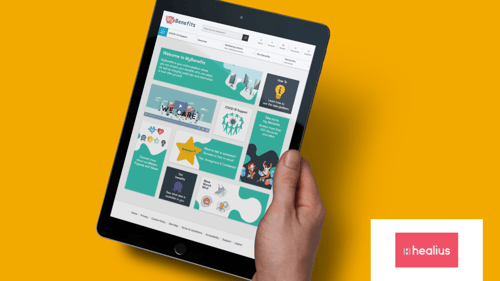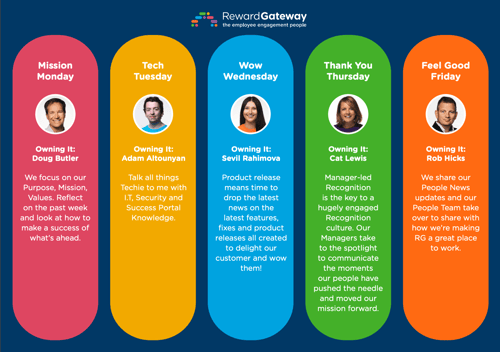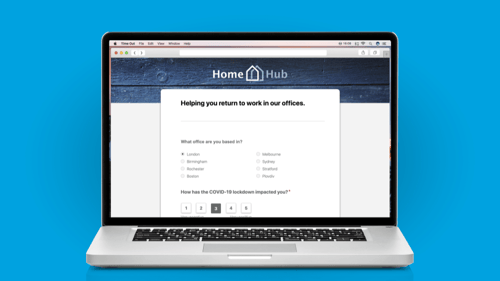Using employee communications to strengthen engagement and connections
8 min read
The first half of 2020 has seen our expectations and experience of the working world turned upside-down — almost overnight, businesses were forced to establish new ways of working. In addition to creating pandemic crisis management teams and reassessing business continuity plans, leaders found themselves adopting new tools and rhythms, and increasing the frequency of company-wide communications to help their people navigate uncertainty and keep abreast of the rapidly changing environment.
Employee engagement may not have been a priority for your leadership team before COVID-19, but if it’s snuck up the list, it's likely because it's a matter of business survival.
While leaders might not be labelling their crisis response plan as an 'employee engagement strategy,' in the midst of uncertainty, we’ve seen organisations shift their focus to the practices that enable and cultivate engagement.
We’ve seen companies establish safety and security for employees by keeping people informed and investing more time in the channels that nurture open and honest lines of communication. In the months of April and May we saw a 96% increase in blog post frequency across our clients’ internal communications platforms, and a massive 560% increase in blog post views by employees (highlighting just how much more employees have sought information at this time).
Leaders have also stepped up to motivate and inspire employees by directing their focus to their company’s purpose and mission, and by recognising the contribution each person is making during this crisis — whether on-site or remotely — to the company's survival and success.
As we prepare for the next chapter and design the future of work, the companies who build on the lessons and practices they established to cultivate connection in response to the crisis may end up with the strongest, most engaged teams.
What strategies can we put in place and build on today to strengthen our teams for tomorrow?
1. Establish frequent, meaningful touchpoints with a centralised communications platform
When COVID-19 was first declared a pandemic, information about it was everywhere. You couldn’t turn on the TV or radio or log onto news sites or social media without hearing or reading about it. It was easy to feel information overload and many organisations looked for a way to provide people with one source of truth that they could come back to, to find relevant government and company updates that would affect their safety, health, work conditions, and day-to-day priorities.
Below is an example of how one of our clients, Healius, moved quickly to create a centralised COVID-19 information hub to keep its workforce of 12,000 informed during the pandemic. Because of the high volume of people already accessing employee benefits for healthcare employees through the platform, Healius extended it to contain company, government and global updates related to COVID-19.

Establishing a reliable communication channel is an important part of giving employees stability and security at a time they need it most. Some companies went so far as to update that channel at a consistent time and day each week, so their people knew when to log on for any safety or work-related updates through the crisis.
Establishing a consistent touchpoint and a regular rhythm of communication is a great practice to take into the future. Now that many of us are working remotely, or having to divide our time between worksites and offices, having a digital channel that employees can access at the time that suits them, wherever they are working from, on any given day, is essential.
Directing all communication to one place means employees know where to access important safety updates, business progress reports, policies, people news and even uplifting and inspiring stories.
When teams are working in different time zones, shifts or locations, a single, digital hub helps cultivate connections that transcend distance and time, by keeping employees informed and on the same page.
In times of uncertainty, change or growth, these internal communications platforms can act like a digital 'campfire' — almost like a digital 'home base' that provides employees security and direction as well as inspiration and warmth.
Using a single communications hub:
-
Avoids email clutter/overwhelm: Instead of having to search email trails and trying to figure out which 'all-staff' message is the most recent or relevant, everything is stored in one searchable news feed.
-
Ensures employees get the most relevant information: Instead of sending blanket messages and communicating with a scattered approach, you can segment messages so that the right people get the right message at the right time, depending on their group/business unit.
-
Improves clarity and interest through multimedia: Nuance and tone can get lost in emails or blog posts, so having the option to embed video in a piece of communication can help when delivering personal messages or challenging news. Seeing someone’s face immediately makes something more human. Including pictures of staff members, or GIFs that grab attention and make comms more relatable to different demographics can all help with getting the right message across.

2. Give employees visibility and a voice with blogging and social communications
With many organisations now working in remote or dispersed environments, having visibility of their progress, wins, concerns and challenges can be harder.
One way you can cultivate more connections across different parts of your business is by enabling leaders from different areas to share updates from their departments and teams.
Giving leaders the power to write and publish blog posts:
-
Enhances the visibility of business activity and progress: This improves understanding as people get insight into what people are working on and the pressures they’re going through, and it encourages cross-team support and celebration for those accomplishments. During times of crisis or change, breaking down company silos can be particularly important for maintaining motivation and morale.
-
Takes the pressure off HR teams to create all the content: Giving other leaders ownership and the tools to tell stories and keep the business updated means you aren’t solely responsible for 'feeding the content beast.' When others invest their time into writing a post, they’ll be more likely to share it and drive readership. Below is an example of the 'content calendar' that our Head of Global Engagement and Internal Communications, Catrin Lewis, uses to keep different leaders accountable for and aware of the different types of content we publish on our internal blogs each week:

-
Invites employees to contribute to the conversation: As a community, we’re used to being socially connected online and most people aren’t happy to just consume information anymore — anyone on Facebook, Instagram or TikTok is used to being a co-creator when it comes to telling stories. Bringing blogging and social functionality to your company gives your employees a voice that’s a little less formal. People are able to comment in a format that’s ‘native’ or ‘natural’ to them, and this gives a platform for conversations to ensure important things aren’t just being said behind closed doors. Enabling public comments cultivates connection by allowing employees to respond and ask questions more organically, and creates a space for employee/leadership interactions in a more informal context, in real time.
3. Keep track of the pulse of the organisation with surveys and data insights
As work safety guidelines and health updates change rapidly, it’s so important to have a channel where leaders can gauge how people are feeling quickly.
Many HR leaders might be tempted to ditch their Annual Engagement Survey because people aren’t in the right frame of mind to do it. Like any annual survey, the results only capture people’s sentiments during a specific period of time, and how can you possibly compare how people were feeling last year with how they're feeling in the middle of a pandemic?
Still, the question remains: How can you create a safe space where people can share open feedback?
Having a survey tool built into your centralised communications platform is handy, as employees are already logging into that system regularly to get information. Conducting a short poll, or even a lengthier survey about how employees are feeling about returning to work can give your People Team very important insight into what’s working, what’s not, and how to plan for the next few months.
Enabling your business to get in-the-moment feedback from employees via surveys:
-
Allows your business to pivot quickly based on feedback from your people: Responding to employee feedback with positive action keeps your business agile and maintaining forward momentum. For example, in March, Reward Gateway conducted a survey about remote working and discovered many of our people didn’t have the space or equipment to work from home effectively long-term. The Leadership Team acted on that feedback very quickly, and launched a new financial employee benefit in response. Our Work From Home Bundle offers all our employees items to improve both the current and future work from home situation.
-
Allows your People Team to gather information efficiently and accurately to help with planning: As employers prepare for the return to work, they have the option to use our Return To Work survey template to get an idea of what their employees want and need to be able to comfortably and safely return to their offices and worksites. To reduce the administrative burden and help HR leaders tick one more thing off their to-do list, we've made this survey template available in our library of evolving surveys for our clients.

-
Cultivates an 'always on' feedback culture where employees are encouraged to provide feedback in one trusted location: Regularly asking for feedback empowers employees to feel like their voice matters and that decisions aren't being made in a vacuum. Having surveys in the same platform as your company-wide communications, employee benefits, or reward and recognition program means the response rate is much higher than if employees had to complete it on a separate system. It is one less email in their inboxes, and requires fewer clicks to get the job done and the survey completed. You can set alerts and reminders to encourage responses, then publish the insights from the results in a future blog post to close the loop.
As employers start to prepare for the next phase of work and navigate the labyrinth of scheduling days in and out of the office, adjusting safety regulations and changing people priorities, the need for open channels of communication will only increase.
I suspect the companies who have the tools and practices in place to cultivate connection and support their people through the next wave of change will find their feet faster and find themselves ahead of their competitors. I hope this post has given you a few ideas to start with — if you’d like to discuss these or share what you’re doing in your own organisation, get in touch.
 Sarina Pearson
Sarina Pearson

